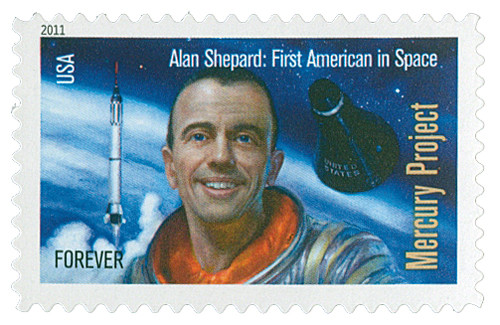
# 4527-28 - 2011 First-Class Forever Stamp - Space Firsts: Mercury Project and Messenger Mission
U.S. #4527
2011 44¢ Space Firsts
Issue Date: May 4, 2011
City: Kennedy Space Center, FL
Quantity: 60,000,000
Printed By: Banknote Corporation of America
Printing Method: Offset, Microprint "USPS"
Color: Multicolored
The U.S. space program has come a long way since the Space Race of the 1950s and 60s. Yet out of this competition have come some of the world’s most significant scientific achievements.
America launched its first satellite in 1958. Just three years later, Alan Shepard became the first American to enter sub-orbital space. With the landing of the first men on the moon in 1969, America effectively won the Space Race. But that was not the end of our space exploration. Since that time, America has collaborated with Russia, our former rival, on the Apollo-Soyuz project and the International Space Station (ISS). The National Aeronautics and Space Administration (NASA) has also overseen missions studying half of our solar system, including Mars, Venus, Mercury, Jupiter, and Saturn.
Although federal budget issues slowed progress, the future of space exploration is still bright. In addition to Messenger beginning the first orbit around Mercury in March 2011, the New Horizons probe, expected to reach and study Pluto in 2015, NASA’s mission statement is: “to improve life here, to extend life to there, to find life beyond.” With proposed projects including more studies of Saturn and the Sun, and a man on Mars by 2037, America’s interest in the final frontier shows no sign of slowing down.
U.S. #4527
2011 44¢ Space Firsts
Issue Date: May 4, 2011
City: Kennedy Space Center, FL
Quantity: 60,000,000
Printed By: Banknote Corporation of America
Printing Method: Offset, Microprint "USPS"
Color: Multicolored
The U.S. space program has come a long way since the Space Race of the 1950s and 60s. Yet out of this competition have come some of the world’s most significant scientific achievements.
America launched its first satellite in 1958. Just three years later, Alan Shepard became the first American to enter sub-orbital space. With the landing of the first men on the moon in 1969, America effectively won the Space Race. But that was not the end of our space exploration. Since that time, America has collaborated with Russia, our former rival, on the Apollo-Soyuz project and the International Space Station (ISS). The National Aeronautics and Space Administration (NASA) has also overseen missions studying half of our solar system, including Mars, Venus, Mercury, Jupiter, and Saturn.
Although federal budget issues slowed progress, the future of space exploration is still bright. In addition to Messenger beginning the first orbit around Mercury in March 2011, the New Horizons probe, expected to reach and study Pluto in 2015, NASA’s mission statement is: “to improve life here, to extend life to there, to find life beyond.” With proposed projects including more studies of Saturn and the Sun, and a man on Mars by 2037, America’s interest in the final frontier shows no sign of slowing down.














